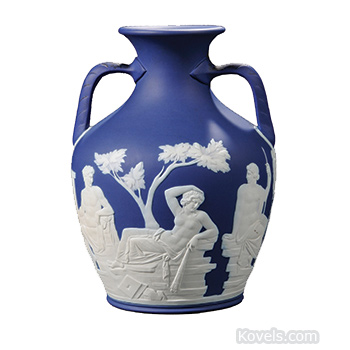Kovels’ Top 20 list of antiques and collectibles is based on the results of hundreds of thousands of searches that took place on Kovels.com. During February 2015, collectors found for prices for: 1) Fenton, 2) Occupied Japan, 3) Coca-Cola, 4) Wedgwood, 5) Bavaria, 6) Dinnerware, 7) McCoy, 8) Stove, 9) Delft, 10) Depression Glass, 11) Capo-Di-Monte, 12) Lamps, 13) Hull, 14) Satsuma, 15) Banks, 16) Lighters, 17) Belleek, 18) Pepsi-Cola, 19) Scales, and 20) Haeger.
Did you know that …
- Occupied Japan (No. 2) collectibles were never sold in Japan. Toys, dishes and other goods marked "Occupied Japan" were made during the American occupation of Japan after World War II, from 1947 to 1952, for the export market only.
- Wedgwood's (No. 4) Josiah Wedgwood (1730-1795), had a disability and was almost not hired by his brother to work in the family pottery. A childhood struggle with smallpox left him with a weak knee and he wasn't able to operate the foot pedal of a potter's wheel. He focused instead on other aspects of pottery—design, glazes and production methods. The leg was eventually amputated and replaced with a wooden one. Wedgwood became one of the most famous potters of all time and the rest is history.
- Delft (No. 9), a type of tin-glazed pottery most think is made in Holland, but it isn't always. Early delft was made in Holland and in England during the 18th century. By 1990, blue and white pottery with Dutch scenes was made in Asia and Germany, but still marked Delft. Only one Dutch company remains that makes traditional old-style delft.
- Depression glass (No. 10) is a type of inexpensive glass made in the 1920s and '30s. It was often given away at movie matinees during the lean years of the Great Depression. It wasn't called Depression glass then—the name Depression glass is a modern one, coined by collectors.
- Belleek (No. 17) isn't always Irish. The first Belleek was made in Ireland in 1857. Pieces made by American companies, including Ceramic Art Co., Lenox, Knowles, Taylor & Knowles, Ott & Brewer and Willets had a similar creamy yellow wet-looking glaze also called belleek. But in 1929, a court ruled that only the Irish company could use the word Belleek with a capital "B." Others had to use belleek with a lowercase "b" in their marks and ads.
Collectors who go to Kovels.com can buy knowing the identifying features, marks and prices of antiques and collectibles. Kovels.com and the book, Kovels' Antiques and Collectibles Price Guide, list thousands of collectibles in hundreds of categories that are described, edited, priced and pictured.




I have a Greek Vase 4 Figurines(Sides)White on the Bottom it is written Athenian Art Ware(with a Robin Hood Head) Frank Beardmore & Co. Fenton A stamp that is 7B Thank You Jack Semall 623-512-9825 Bricky10@aol.com Please call if it’s a Rare Piece Thanks again